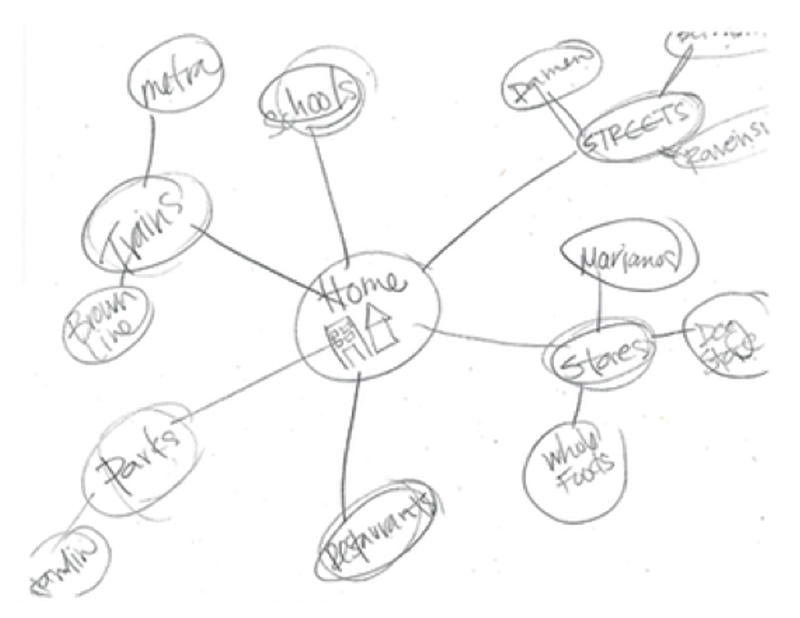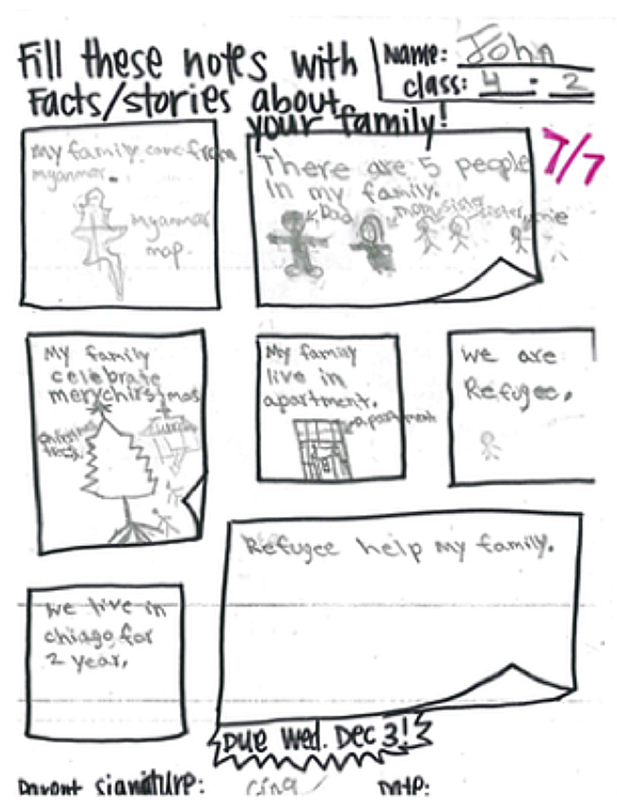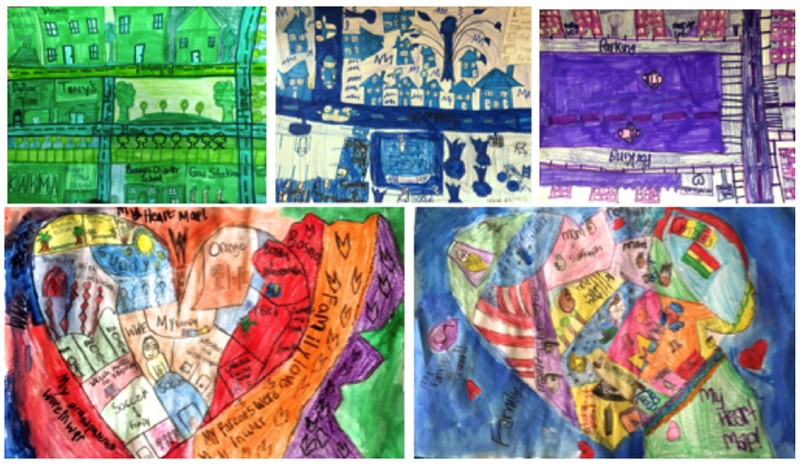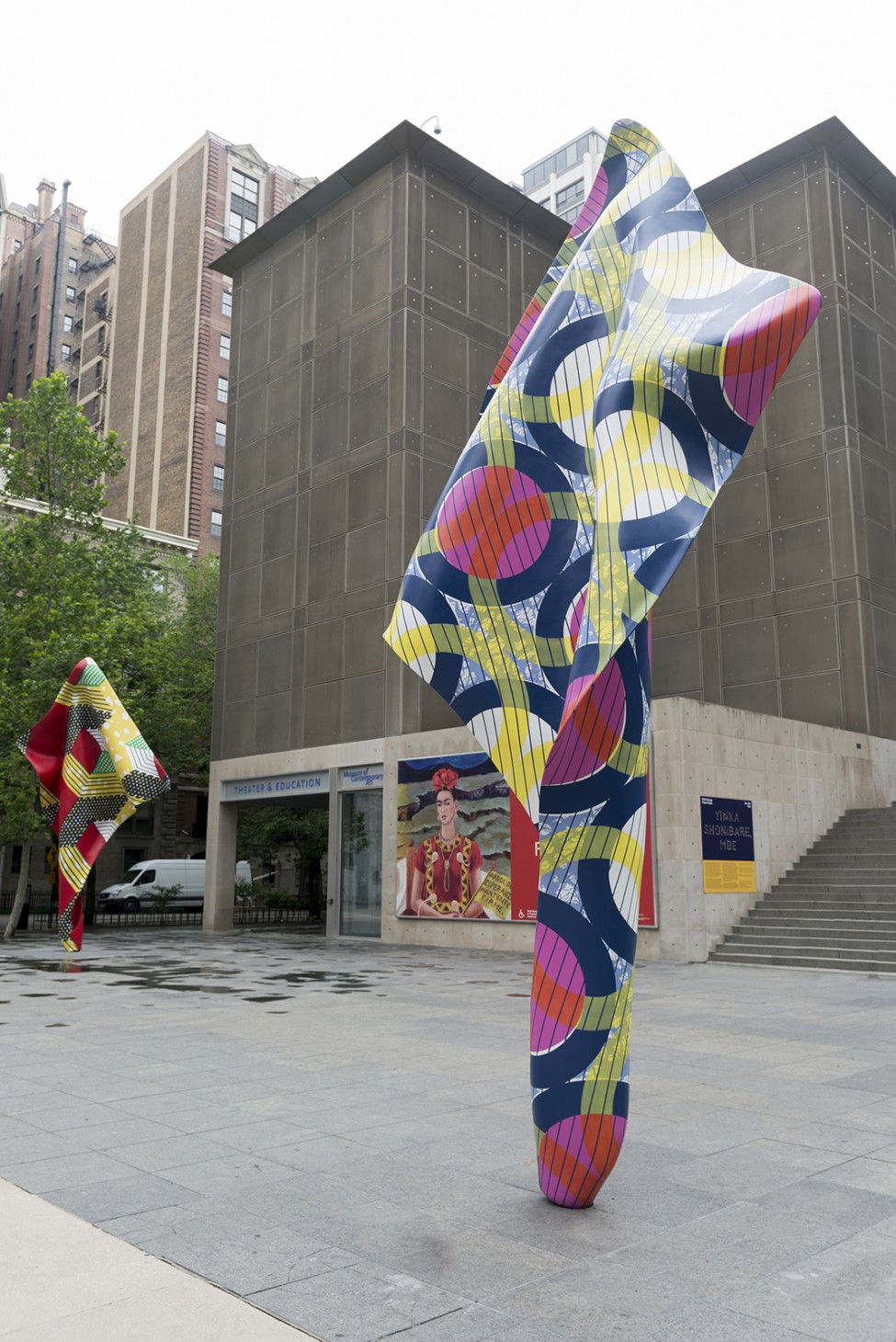Maps as Self-Portraits: Self + Story
An exploration of place, movement, and belonging with 4th and 5th grade students from around the world.
By Katie Preston

My classroom accommodates preK-8th grade students, and I like to create projects that build and connect throughout the grade levels. The majority of our students are refugees who either immediately or very recently came to the United States. Many are coming directly from refugee camps in Africa and the Middle East. They face a variety of challenges, from emotional/behavioral issues to knowing no English, and even separation from members of their family who remain in their country of origin.
My goal in this unit was to create a series of projects that could connect their two worlds, and create connections with their peers, not just through where they’ve come from, but also through where they currently live. Many students live in the same neighborhoods and are adapting to new environments, and the contemporary aspect of these projects was to create a dialogue while making artworks that are relevant and relatable to the students.
Through the world map, students were able to have conversations involving geography and visually draw connections from all over the world to Chicago, where we all now live. Because we displayed this map publicly, even the grades that weren’t involved in the actual creation of the project began conversations or posed questions that created additional dialogues outside of the classroom.
The neighborhood maps forced students to pull from their memories their visual surroundings around their current homes. Street names, restaurants, stores, schools, and parks helped us to slowly build a visualization of the neighborhoods they each live in. While brainstorming, students found that they lived near common landmarks and streets, and often in the same building. They were excited to be able to identify their area as their home.
The final project incorporated many of the topics and ideas created by the dialogue from the first two projects. Students looked at contemporary artists who incorporate parts of their identity in their artwork in different ways, and then created symbolic heart maps with all the pieces that make up their identities. We also used photos to create a silhouette to overlap and interact within their map. They had fun exploring what poses represented their personalities in choosing how they would overlap in the project.
This unit included the following Projects/Activities:
- Collective World Map: Representing the pilgrimage to Chicago, Illinois
- Maps from Memory: Neighborhood maps in monochromatic colors
- Identity Maps: Heart maps with a silhouette overlay
Within this unit, we explored the following Big Ideas:
- Community and self-portraits
- The parts of our experience that form our identities
- Ways to portray/document a community
- Mapping experience/identity/emotion
- Memory mapping/telling our stories
We addressed the following Questions:
- How can we use visual representations of our experiences to create a map of our identities? (Self-portrait)
- What is a geographical map vs. a creative map?
- How do many pieces make up who we are?
- How do we map our neighborhood?
- How do we map our emotions and heart?
- How can we create a collaged self-portrait through mapping?

Project 1: Collective World Map
- Symbolize the story of pilgrimage through creating a group map of the countries you came from. (25.A.2d)
- Work as a group to design and collage a collective world map that helps us form connections as individuals and as a community. (26.B.2d)
- Demonstrate the similarities and differences of our school by creating a visual representation of travel. (27.B.2)
Project 2: Maps from Memory
- Demonstrate line and shape to create a map drawing of your neighborhood. (25.B.2)
- Observe and draw a map of your neighborhood from memory. (26.B.2d)
- Identify and draw the various places in your neighborhood environment and show how it relates to our school environment. (27.A.2a)
Project 3: Identity Maps
- Recognize/organize a variety of experiences as visual representations to express your own self-portrait. (25.B.2)
- Design and construct your own self-portrait map collage. (26.B.2d)
- Demonstrate how the combination of visual representations from many parts of our lives can communicate our identities. (27.B.2)

Documentation + Assessment Suggestions
Project 1: Collective World Map
Students were assessed on their ability to complete the homework worksheet, and on their participation in the collective painting. They got points for filling in the worksheets with descriptions or pictures. Also if they were able to work as a team with their peers during the world map collective painting, and knew how to use their take-home sheet as a reference, they received points for that as well.
Project 2: Maps from Memory
Students were assessed on their integration of their memory maps into their final projects, and on their use of space and monochromatic colors. When grading their neighborhood maps, I looked to see if they had incorporated all of the places in their web maps within the final drawing of their neighborhood, and also checked for demonstration of their knowledge of monochromatic colors.
Project 3: Identity Maps
Students were assessed on their completion of their heart maps, on the craftsmanship of materials in their silhouette, and on the completion of the painting around it. Students got points for using the correct materials in the right areas of their maps. They also received points for completing the heart maps with their own drawings and descriptions. Lastly, they got points for the neatness and visibility of their silhouette within the painting.
Learning Activities
Projects 1 + 2 — Maps: From World to Neighborhood
- Discuss… Contemporary artists Janice Caswell and Lucie Conoley. Compare and contrast abstract and tangible mapmaking vs. detailed representation of a specific place.
Complete Worksheet… Find the country your family and ancestors are from. Mark the country with a star, the name of the area, and the language spoken there. (This is a take-home worksheet that students complete at home with parents.) - Draw… a line with pins and string to connect where you’re from to Chicago, and use paint to make a permanent mark of pilgrimage. Anchor one pin with several long strings to Chicago; have each student place a pin in the country of their origin. (They may not know where exactly in the country so I just had them choose a spot within the borders if they did not know.) Allow students to choose a string to connect and wrap around their pin. Then, following the string with a paintbrush, they create a straight line. When they’re done they can remove their pin and string for the next student’s turn.
Investigate… a memory map/web diagram, writing down from memory all of the landmarks in your neighborhood (streets, stores, restaurants, schools, parks, etc.). I drew my example step-by-step so students could follow my thought process; you could also create a worksheet with the general outline of the web, and have them just add the specific details. However, some of their webs were very interesting when they had to draw their own, and several even included little drawings or pictures. - Design… Your neighborhood map starting with your streets first, and draw the rest around your home. Choose one color to use to add monochromatic color to your neighborhood map. (Use a variety of thick and thin markers for the main aspects of your drawing: buildings, roads, trees, etc. Use a variety of colored pencils and values to fill in the remaining space of your drawing.)
- Install… the collective painting in the school for all students to identify and visualize how far they’ve traveled, and to reflect on the diversity of our the student population. Installing the work in the hallway allows other students to see and draw connections through their neighborhood to the map.
Project 3 — Identity Maps: Self and Family
- Discuss… contemporary artists Joseph Grigley and Yinka Shonibare. Compare and contrast ways artists incorporate identity into their artworks: memories and conversations vs. ideas and images from culture.
- Draw… a heart map with all of your favorite people, places, things, and images that represent who you are. I had a general guide worksheet with suggestions to create several pieces. Depending on the size of the heart they drew, and the shape and size of the pieces within, some students had many extra spaces. In those spaces I allowed them to add their own ideas or drawings.
- Photograph… yourself in a pose of your choice to use as a silhouette to overlap your self-portrait map, cutting out the photo to use it as an outline. While students were working on drawing their heart maps, I pulled them into the hallway in groups of 3 or 4 to take their photographs. Pulling them in groups allowed them to work out some different ideas for their poses, and allowed the more shy students to have peer support and suggestions.
- Investigate… where your family came from before arriving in Chicago (take-home worksheet on family stories and traditions). I wanted this to be fairly interpretive; many of my student’s parents don’t know any English. I created a variety of notepaper shapes with Joseph Grigley’s artwork in mind, so that students and their families could fill these in using words or drawings. The back of the worksheet has ideas and suggestions in case they need them.
- Complete Worksheet… Worksheet 3: traditions and stories about your culture and family. Have a conversation with your family and write down and/or draw 7 stories and traditions.
- Design… your heart map as a self-portrait to include traditions and stories from your worksheet, and overlay your silhouette to interact with your map. Choose a composition for your silhouette that creates balance, and outline your photograph. Use crayons to add color to the areas inside your silhouette. Use watercolor pencils and paint to finish adding color to the rest of your drawing. The silhouette creates a wax-resist effect so the silhouette is subtle, but present, in your self-portrait map. This was broken down into steps, with students using a specific material each day:
- Day 1: Crayon to fill in the areas within the silhouette
- Day 2: Watercolor pencils to color the rest of the heart
- Day 3: Adding details from the worksheet and outlining them in crayon
- Day 4: Watercolor paint to complete the space around the heart and silhouette. Some choose a solid color; some use patterns and designs.
- Install… your work in the hallway for other students to see and draw connections through their self-portrait maps.

Materials + Supplies
Project 1: Collective World Map
- Large canvas material 36X60 inches
- Sharpies
- Acrylic paint (multiple colors)
- Paint brushes
- String
- Push Pins
Project 2: Maps from Memory
- White drawing paper 9X12
- Pencil & Colored Pencil
- Markers (thick and thin)
Project 3: Identity Maps
- White drawing paper, 12 X 18 inches
- Crayons and sharpeners
- Watercolor pencils
- Watercolor paint
- Paint Brushes
- Photograph for the silhouette
- Scissors
MCA Connections
Students took a field trip to the MCA where they saw work by one of the artists for their third project, Yinka Shonibare. They were able to engage in dialogue on how Yinka Shonibare creates artwork that references his culture visually and conceptually. After the visit, students completed a take-home worksheet with their families with stories and traditions from their culture, incorporating these into their self-portrait heart maps.
Resources
Contemporary Artist References:
Katie Preston
Passages Charter School
Katie Preston holds a BFA from The School of the Art Institute of Chicago (SAIC) in fine art and art education. She is the visual art teacher at Passages Charter School, a preK-8th grade charter school in Andersonville, Chicago. The demographic at her school is mainly refugees from Africa, Asia, and the Middle East. One of her main goals has been implementing art therapy techniques and approaches for refugees, special education students, and for the rest of the student population.
Katie reflects on her creative process
The process of developing this curriculum was an exciting one; through the Professional Development Sessions at the MCA I was able to refresh my knowledge about how I can view and share contemporary art with my students. The MCA motivated me to create projects that could help connect our students through their experiences as refugees, not just in terms of where they came from, but also by finding a new identity in a brand new environment.
Many of my students are Nigerian, so when I saw Yinka Shonibare’s sculptures outside the museum I realized there was an opportunity for them to draw connections to their own culture through his artwork. I then looked for artists who incorporated aspects of their identities in a visual way through artwork. I wanted the projects to reference the global diversity of my students, so a world-to-neighborhood idea for projects started to evolve. The first two of my projects were completed in a parallel process. They used Janice Caswell as inspiration to create a more tactile map using tacks and string, drawing physically tangible connections from their countries of origin to Chicago. They used Lucie Conoley as inspiration to create web diagrams from memory, with the centers being their homes, using the webs to create maps of their neighborhoods.
Students began to not just be able to describe where things were in their neighborhood; stories also began to evolve out of these drawings. Students were able to draw a connection through what they were making to another student’s work of art, and a dialogue among students was formed around these works of art during the process of creating.
I’ve always integrated contemporary art and artists in my curriculum. This process has validated the value of contemporary art for young lives. It serves as a more tangible and relatable experience of creating. Contemporary art in many ways reinforces the approaches of Common Core and Whole Brain Thinking with its creation of dialogue. Most people and even students think that you have to fall into the space of either an artist or teacher, but through this process I’ve realized that the two aren’t that fundamentally different. Good and effective teachers have to be creative in their teaching, and some artists view their teaching as part of their work, and continue a separate kind of work outside of the classroom. When these two can be fused together, I think it creates a really great opportunity, not for the artist, but for those that you aim to inspire.

